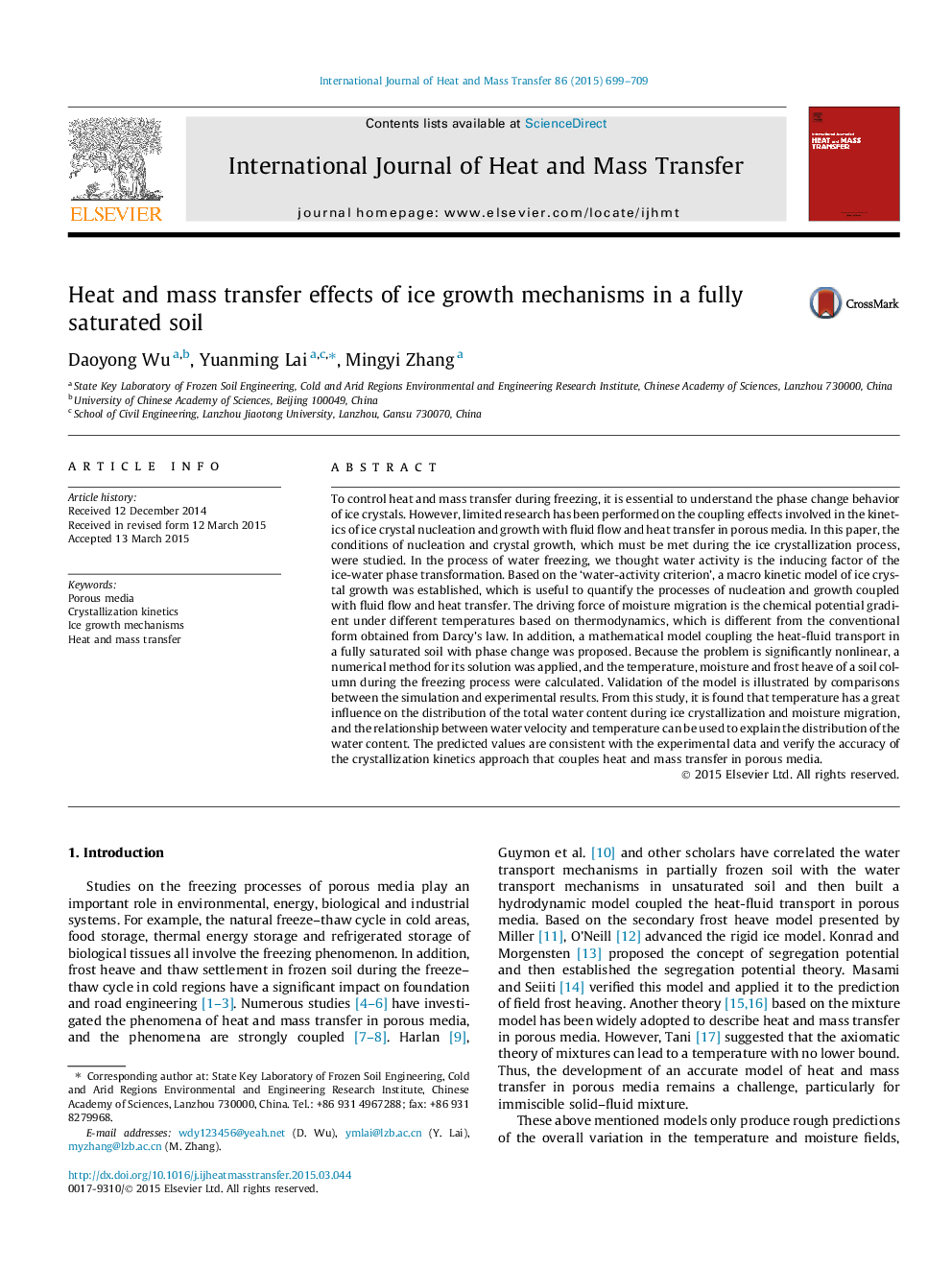| کد مقاله | کد نشریه | سال انتشار | مقاله انگلیسی | نسخه تمام متن |
|---|---|---|---|---|
| 656773 | 1458056 | 2015 | 11 صفحه PDF | دانلود رایگان |
عنوان انگلیسی مقاله ISI
Heat and mass transfer effects of ice growth mechanisms in a fully saturated soil
ترجمه فارسی عنوان
اثرات انتقال گرما و جرم در مکانیسم رشد یخ در یک خاک کاملا اشباع شده
دانلود مقاله + سفارش ترجمه
دانلود مقاله ISI انگلیسی
رایگان برای ایرانیان
کلمات کلیدی
رسانه های متخلخل، سینتیک بلوری شدن، مکانیسم رشد یخ، انتقال حرارت و جرم،
ترجمه چکیده
برای کنترل انتقال گرما و جرم در طی انجماد، برای شناخت رفتار تغییر فاز بلورهای یخ ضروری است. با این حال، تحقیقات محدود شده بر روی اثرات اتصال درگیر در سینتیک هسته ی هسته ی کریستال یخ و رشد با جریان مایع و انتقال حرارت در رسانه های متخلخل انجام شده است. در این مقاله، شرایط هسته زدایی و رشد کریستال، که باید در طی فرایند کریستال ییل مورد بررسی قرار گیرد، مورد بررسی قرار گرفت. در فرایند انجماد آب، تصور می کنیم که فعالیت آب، عامل القاء تبدیل فاز یخ و آب است. بر اساس معیار «فعالیت آب»، یک مدل کینتیکی کریستال یخ کریستال یخ ایجاد شد که برای اندازه گیری فرآیندهای هسته ای و رشد همراه با جریان سیال و انتقال حرارت مفید است. نیروی محرکه مهاجرت رطوبت، شیب پتانسیل شیمیایی تحت دمای مختلف بر اساس ترمودینامیک است که متفاوت از فرم معمولی است که از قانون دارسی گرفته شده است. علاوه بر این، یک مدل ریاضی انتقال حرارت حرارتی در خاک کاملا اشباع شده با تغییر فاز پیشنهاد شده است. از آنجا که این مسئله به طور قابل توجهی غیر خطی است، یک روش عددی برای راه حل آن اعمال شد و درجه حرارت، رطوبت و فراست از یک ستون خاک در طی فرآیند انجماد محاسبه شد. اعتبارسنجی مدل با مقایسه مقادیر شبیه سازی و نتایج تجربی نشان داده شده است. از این مطالعه مشخص شده است که درجه حرارت تاثیر زیادی بر توزیع مقدار کل آب در طی کریستالیزاسیون یخ و مهاجرت رطوبت دارد و ارتباط بین سرعت آب و دما می تواند برای توضیح توزیع محتوای آب استفاده شود. مقادیر پیش بینی شده با داده های تجربی سازگار است و صحت روش سینتیک بلوری را بررسی می کند که انتقال گرما و جرم در رسانه های متخلخل همراه است.
موضوعات مرتبط
مهندسی و علوم پایه
مهندسی شیمی
جریان سیال و فرایندهای انتقال
چکیده انگلیسی
To control heat and mass transfer during freezing, it is essential to understand the phase change behavior of ice crystals. However, limited research has been performed on the coupling effects involved in the kinetics of ice crystal nucleation and growth with fluid flow and heat transfer in porous media. In this paper, the conditions of nucleation and crystal growth, which must be met during the ice crystallization process, were studied. In the process of water freezing, we thought water activity is the inducing factor of the ice-water phase transformation. Based on the 'water-activity criterion', a macro kinetic model of ice crystal growth was established, which is useful to quantify the processes of nucleation and growth coupled with fluid flow and heat transfer. The driving force of moisture migration is the chemical potential gradient under different temperatures based on thermodynamics, which is different from the conventional form obtained from Darcy's law. In addition, a mathematical model coupling the heat-fluid transport in a fully saturated soil with phase change was proposed. Because the problem is significantly nonlinear, a numerical method for its solution was applied, and the temperature, moisture and frost heave of a soil column during the freezing process were calculated. Validation of the model is illustrated by comparisons between the simulation and experimental results. From this study, it is found that temperature has a great influence on the distribution of the total water content during ice crystallization and moisture migration, and the relationship between water velocity and temperature can be used to explain the distribution of the water content. The predicted values are consistent with the experimental data and verify the accuracy of the crystallization kinetics approach that couples heat and mass transfer in porous media.
ناشر
Database: Elsevier - ScienceDirect (ساینس دایرکت)
Journal: International Journal of Heat and Mass Transfer - Volume 86, July 2015, Pages 699-709
Journal: International Journal of Heat and Mass Transfer - Volume 86, July 2015, Pages 699-709
نویسندگان
Daoyong Wu, Yuanming Lai, Mingyi Zhang,
